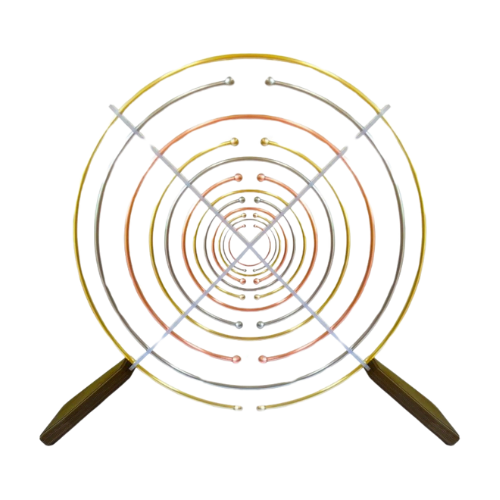Read the answers to the most frequently asked questions here
A multiwave oscillator (MWO) is a device that emits a spectrum of electromagnetic frequencies, typically in the radiofrequency range, with the intention of promoting health and well-being. The concept behind MWO's, developed by inventor Georges Lakhovsky in the early 20th century, is based on the idea that every living cell has its own resonant frequency and that exposing cells to specific frequencies can increase their vitality and resilience.
The MWO works by generating a combination of harmonic frequencies, which are believed to interact with the body's own electromagnetic field. Proponents of MWO therapy suggest that these frequencies can help stimulate cell regeneration, improve circulation, and support the body's natural healing processes. The device typically consists of an antenna or coil connected to an oscillator that produces the electromagnetic field.
During a session with a multiwave oscillator, clients can sit or lie near the device while it emits electromagnetic frequencies. The duration and frequency of sessions may vary depending on individual needs and treatment goals. Many people report feeling relaxed and energized after using MWO's, although the scientific evidence supporting their efficacy is limited, and they should not be considered a substitute for conventional medical treatments.
Multiwave oscillators are often used as complementary or alternative therapies to support overall well-being, rather than as treatments for specific medical conditions. While individual responses may vary, some people report experiencing benefits for a range of health issues.
Here are some general areas where people may seek MWO therapy:
A Rife plasma lamp is a device that emits specific frequencies of electromagnetic energy, similar to a multiwave oscillator, but with some differences in technology and application. It is based on the principles of frequency therapy, which states that different frequencies can have specific effects on the body, including promoting healing and well-being.
Here is an overview of a Rife plasma lamp and how it differs from other therapies:
While Rife plasma lamps may offer a unique approach to well-being, their efficacy and safety should generally be carefully evaluated, and they should be used as part of a comprehensive health plan under the guidance of qualified professionals.
The safety of multiwave oscillators and Rife plasma lamps depends on several factors, including how they are used, the duration of exposure, and individual health considerations. Here are some points to consider regarding their safety:
When a person is significantly out of balance, it is possible that some discomfort may be experienced after the first sessions. The body is in the process of restoring and balancing itself at that time. It is therefore important to properly coordinate the frequency of sessions with one of the specialists. Drinking water during the session reduces this, as the body produces many waste products.
While multiwave oscillators and Rife plasma lamps may offer potential benefits for some individuals, it is essential to prioritize safety and use these therapies responsibly under the guidance of qualified specialists.
Generally, a multiwave oscillator session lasts 20 minutes. For a long-term course, it may be chosen to gradually build up to 20 minutes per session to allow the body to adapt more gently.
A session with the Rife lamp depends on the purpose of the session. Generally, a session takes 10 to 20 minutes.
The recommended number of sessions for optimal results with the multiwave oscillator and Rife plasma lamp may vary. This depends on several factors, including individual health concerns, treatment goals, and response to therapy. Here are some general guidelines to consider:
Ultimately, the recommended number of sessions for optimal results will be determined on a case-by-case basis, taking into account your individual health needs and treatment goals. Trust our expertise and guidance in developing a personalized treatment plan that best suits you.
Generally, anyone can walk in. However, we cannot guarantee that a multiwave oscillator will be available for you. It is therefore advisable to make an appointment in advance or call us for availability.
The multiwave oscillator passes through all materials except metals. We therefore advise removing and putting away all metals and electronics. This ensures a pure frequency.
For treatment with the Rife lamp, it is important that the lamp makes direct contact with the skin. Comfortable clothing is recommended for this.
Yes, in many cases, multiwave oscillator and Rife plasma lamp sessions can be combined with other complementary or conventional therapies to improve overall well-being.
Want to experience what we can do for you? Schedule an appointment right away.
